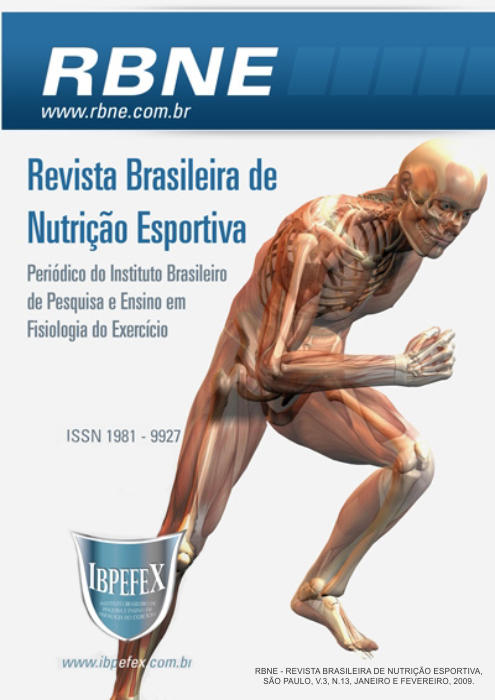Resist training circuit with weight and supplementation of ômega-3 improves symptoms under the pain in adult women bearer of fibromyalgia
Abstract
Fibromyalgia is a rheumatic syndrome non-articulate, from ignored origin, characterized by diffuse and chronic muscle-skeleton pain and presence of several tangible pain areas, denominated tender points. The present study has as objective verifies if there was symptom alteration on the pain picture of an adult woman, fibromyalgia bearer, submitted to resisted training with omega-3 supplement in capsules, during eleven weeks with purpose of verifying the association of the training to the supplementation in the improvement of her pathological picture. Materials and Methods: Forty-eight year-old teacher complains about strong pains for the whole body, being diagnosed two years ago as fibromyalgia bearer. She was submit to a resist circuit training with weights, on inserted days and omega-3 supplementation in capsules of 1000mg, ingesting two capsules daily. Results: Before starts supplementation and training, pain episodes were daily and with very high intensity. With the beginning of the training and supplementation, the pain episodes and intensity began to decrease, becoming more and more spaced during the study. Conclusion: it can be affirm that the combination of moderate intensity resisted exercise together with omega 3 supplementation is capable to lessen pain frequency and intensity on fibromyalgia patients.
References
Assis, M.R.; Silva, L.E.; Alves, A.; Pessanha, A.P.; Feldman, D.; Barros, N.T.L.; Natour, J. Deep water running - an aquatic exercise to treat fibromyalgia: a randomized, controlled study . Arthritis and Rheumtology. Vol. 48: S303. 2003.
Castro, G.; Maria, I.; Acidos grasos omega-3: beneficios y fuente. Iterciencia. Caracas. Vol. 27. Num. 3. 2002. p. 128-136.
Figueroa, A.; Kingsley, J.D.; McMillan, V.; Panton, L.B. Resistance exercise training improves heart rate variability in women with fibromyalgia. Clinical Physiology and Functional Imaging. 2007. p. 01-06.
Garófolo, A.; Petrilli, A.S. Balanço entre ácidos graxos ômega-3 e 6 na resposta inflamatória em pacientes com câncer e caquexia. Revista de Nutrição de Campinas. Vol. 19. Num. 5. 2006. p. 611-621.
Geel, S.; Robergs, R.A. The effect of graded resistance exercise on fibromyalgia symptoms and muscle bioenergetics: a pilot study. Arthritis Care and Research. Vol. 47. 2002. p.82-86
Häkkinen, A.; Häkkinen, K.; Hannonen, P.; Alen, M. Strength training induced adaptations in neuromuscular function of premenopausal women with fibromyalgia: comparison with healthy women. Annalen Rheumatic Disease. London. Vol. 60. 2001. p. 21-26.
Häkkinen, K.; e colaboradores. Effects of Strength training on muscle strength, cross-sectional area, maximal electromyographic activity, and serum hormones in premenopausal women with fibromyalgia. The Journal of Rheumatology. Vol. 29. Num. 6. 2002. p. 1287-1295.
Haun, M.V.; Ferraz, M.B.; Pollak, D.F. Validação dos critérios do Colegiado Americano de Reumatologia (1990) para classificação da Fibromialgia em uma população brasileira. Revista Brasileira de Reumatologia. Vol. 39. 1999. p. 221 -230.
Jones, K.D.; Clarck, S.R. Individualizing the exercise prescription for persons with fibromyalgia. Rheumatic Disease Clinics North American. Vol. 28. 2002. p. 419 - 436.
Marques, P.A.; Rhoden, L; Siqueira, J.O.; e colaboradores. Avaliação da dor em pacientes com fibromialgia, osteoartrite e lombalgia. Revista Hospital das Clinicas, Vol.56. Num.1. p.5 - 10.
Martin, Clayton Antunes.; e colaboradores. Ácidos graxos poliinsaturados ômega-3 e ômega-6: importância e ocorrência em alimentos. Revista de Nutrição de Campinas. Vol. 19. Num. 6. 2006 .
Pagano, Tathiana.; e colaboradores. Assessment of anxiety and quality of life in fibromyalgia patients. Sao Paulo Medical Journal. Vol. 122. Num. 6. 2004. p. 252-258.
Simopoulos, A.P. Omega-6/omega-3 essential fatty acid ratio and chronic diseases. Food Reviews Internacional. Vol. 20. Num.1. 2004. p. 77-90.
Trevor, A.M.; Chem, C.P.; Beilin, L.J. Omega-3 Fatty Acids and Inflammation. Current Arteriosclerosis Reports. Itália. Vol. 2004. p. 461-467.
Valim, V. Benefícios dos Exercícios Físicos na Fibromialgia. Revista brasileira de reumatologia. São Paulo. Vol. 46. Num. 1. 2006. p. 49-55.
Valim, V.; Oliveira, L.M.; Suda, A.L.; e colaboradores. Aerobic fitness effects in fibromyalgia. The Journal of Rheumatololgy. Vol. 30. 2003. p. 1060-1069.
Wolfe, F.; Smythe, H.; Yunus, M.; Bennett, R. The American College of Rheumatology Criteria for the Classification of Fibromialgia. Arthritis and Rheumatism. Vol. 33. 1990. p. 160-172.
Authors who publish in this journal agree to the following terms:
- Authors retain the copyright and grant the journal the right of first publication, with work simultaneously licensed under the Creative Commons Attribution License BY-NC which allows the sharing of the work with acknowledgment of the authorship of the work and initial publication in this journal.
- Authors are authorized to enter into additional contracts separately for non-exclusive distribution of the version of the work published in this journal (eg, publishing in institutional repository or book chapter), with acknowledgment of authorship and initial publication in this journal.
- Authors are allowed and encouraged to post and distribute their work online (eg, in institutional repositories or on their personal page) at any point before or during the editorial process, as this can bring about productive change as well as increase impact and impact. citation of published work (See The Effect of Free Access).






